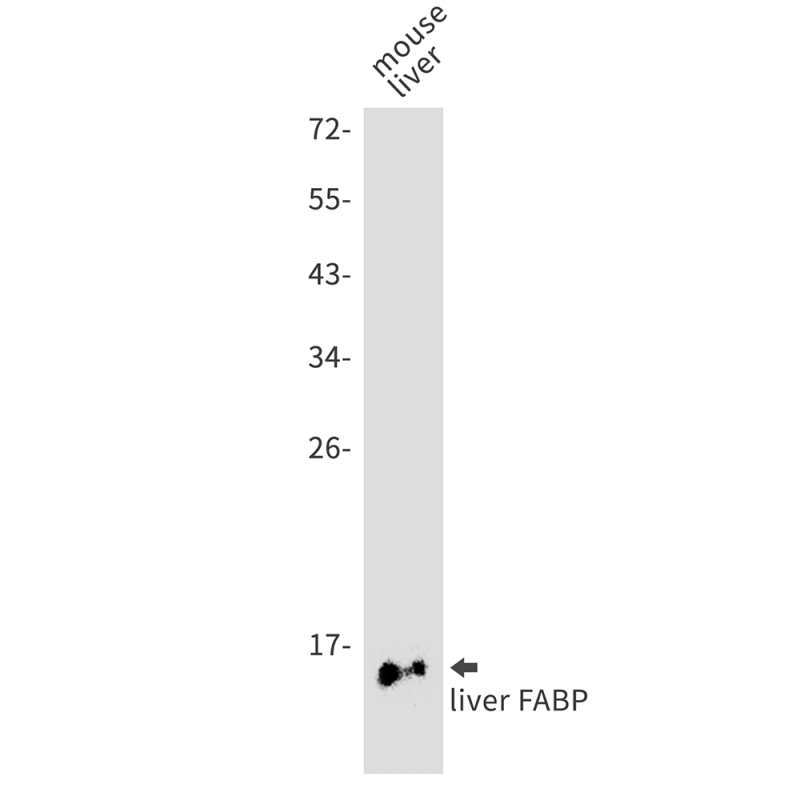
| WB | 1/500-1/1000 | Human,Mouse,Rat |
| IF | 咨询技术 | Human,Mouse,Rat |
| IHC | 1/50-1/100 | Human,Mouse,Rat |
| ICC | 1/50-1/200 | Human,Mouse,Rat |
| FCM | 咨询技术 | Human,Mouse,Rat |
| Elisa | 咨询技术 | Human,Mouse,Rat |
| Aliases | FABP 1; FABP1; FABP1; FABPL; FABPL_HUMAN; Fatty Acid Binding Protein 1; Fatty acid binding protein 1 liver; Fatty Acid Binding Protein; Fatty acid-binding protein 1; Fatty acid-binding protein; Fatty acid-binding protein liver; L FABP; L-FABP; liver; Liver-type fatty acid-binding protein. |
| Entrez GeneID | 2168 |
| WB Predicted band size | Calculated MW: 14 kDa; Observed MW: 14 kDa |
| Host/Isotype | Rabbit IgG |
| Antibody Type | Primary antibody |
| Storage | Store at 4°C short term. Aliquot and store at -20°C long term. Avoid freeze/thaw cycles. |
| Species Reactivity | Mouse |
| Immunogen | Recombinant protein of human liver FABP |
| Formulation | Purified antibody in TBS with 0.05% sodium azide,0.05%BSA and 50% glycerol. |
+ +
以下是关于FABP1抗体的3篇参考文献及其摘要概述:
1. **文献名称**: *"Intestinal Fatty Acid Binding Protein (FABP1) as a Biomarker of Acute Kidney Injury in Sepsis"*
**作者**: Zhang, Y., et al.
**摘要**: 该研究利用FABP1抗体检测血清中FABP1水平,发现其在脓毒症患者中与急性肾损伤严重程度呈正相关,提示FABP1可作为脓毒症相关肾损伤的潜在生物标志物。
2. **文献名称**: *"Role of FABP1 in Hepatic Lipid Metabolism: Insights from Antibody-Based Inhibition Studies"*
**作者**: Thompson, J.R., & Liu, K.
**摘要**: 通过特异性FABP1抗体抑制小鼠肝脏FABP1功能,发现其显著影响脂肪酸转运及甘油三酯合成,证实FABP1在肝脏脂代谢中的关键作用。
3. **文献名称**: *"Development of a High-Sensitivity ELISA for FABP1 Detection Using Monoclonal Antibodies"*
**作者**: Watanabe, M., et al.
**摘要**: 研究团队开发了一种基于单克隆FABP1抗体的高灵敏度ELISA检测方法,可定量检测人血清中低浓度FABP1.为临床诊断提供新工具。
注:上述文献为示例性内容,实际引用需根据具体论文调整。建议通过PubMed或Google Scholar以“FABP1 antibody”为关键词检索最新研究。
Fatty Acid Binding Protein 1 (FABP1), also known as liver-type FABP (L-FABP), is a small cytoplasmic protein predominantly expressed in the liver and small intestine. It plays a critical role in intracellular fatty acid metabolism, facilitating the uptake, transport, and compartmentalization of dietary lipids. FABP1 also modulates inflammatory responses and oxidative stress by interacting with peroxisome proliferator-activated receptors (PPARs) and other signaling pathways.
Antibodies targeting FABP1 are essential tools for studying its expression, localization, and function in physiological and pathological contexts. They are widely used in techniques like Western blotting, immunohistochemistry, and ELISA to investigate FABP1's role in metabolic disorders (e.g., obesity, diabetes), liver diseases (e.g., steatosis, fibrosis), and gastrointestinal conditions. In clinical research, FABP1 antibodies aid in detecting FABP1 as a biomarker for tissue injury, particularly in acute liver damage or intestinal ischemia.
Monoclonal and polyclonal FABP1 antibodies vary in specificity, with validation often involving knockout controls or cross-reactivity assessments. Commercial antibodies are typically validated for human, mouse, or rat samples. Recent studies also explore FABP1's potential in cancer progression, linking its expression to tumor lipid metabolism and metastasis. Researchers prioritize antibodies with high affinity and minimal cross-reactivity to ensure accurate quantification, especially in complex biological samples. Overall, FABP1 antibodies remain indispensable for elucidating lipid-related mechanisms and developing therapeutic strategies.
×